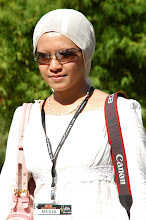As appeared in Features
The Brunei Times -- Aug 25, 2007
SARAWAK'S northernmost town of Lawas usually suffers alienation due to its location, lack of size and infrastructure and from being just a spit of land between Brunei's Temburong and Sipitang in Sabah.
Travellers taking the road between Sabah and Brunei and further to the main body of Sarawak, have no real cause to stop in Lawas. Just two hours from the Sabah border and they're already in Temburong; another hour and they can stop in the bigger town of Limbang.
Last weekend, however, it was the place to be, as the biannual Lawas Fest turned the sleepy town into a hotbed of entertainment, competition and, ironically, camaraderie between neighbours who usually eye each other over the border hedge holding pitchforks. Figuratively speaking, of course.
The first sign of this link between the districts, separated for more than 100 years after the ceding of territories, is the theme of the Lawas Fest: "Maitah ke Lawas: Bisai Hantap, Ma Taga"
Some of you are nodding in understanding. But for those not in the know, it's an amalgamation of the three main dialects spoken in the area: Brunei Malay, Kedayan and Murut (otherwise known as Lun Bawang). Maitah Ke Lawas in Brunei Malay means "Come to Lawas" while Bisai Hantap is Kedayan and Ma Taga is Murut for "It's very interesting".
Pretty diverse for a small area with only 40,000 people, but that's Lawas, the last Brunei territory to be ceded to the Brooke administration in 1905.
The cleaving of the territories has since created great rivalries, especially in the sporting arena, which fits very well, of course, into the excitement of such a festival. Otherwise, there would be no hollering of encouragement and insults, no aching bodies, no sweat exerted for pride as teams from the territories of Limbang, Lawas, Beaufort, Sipitang, Papar and Brunei Darussalam battled it out in the regatta, top-spinning and the always popular tug-of-war.
And certainly no ringing of event venues with thousands of bodies, a sight which was impressive as the regatta went on -- hundreds of metres of river bank, on both sides of Batang Lawas, 10-deep with screaming spectators.
The excitement of the competition was even more, at times, than the entertainment offered at the three-day festival. Traditional dances, a police brass band, VIPs being pulled into dancing the "poco-poco" and a clown with balloons kept the visitors occupied on the first day in between events and trips to the food stalls, while the second day featured a concert and a fireworks display.
An event that was both entertaining and competitive was, of course, the bull race, a wholly local pursuit which was a crowd puller.
Laughingly called the Formula One (and Formula Two) bull race, the running of the beasts, with riders sometimes struggling not to slide off, was fun to watch not for the outcome, but for the handling of the ornery creatures.
Bulls are not racers by nature, and there is no one method which works in making the lumbering beasts head quick-time for the finish line, especially if you've created a track with corners. Some of the "cowboys" managed to get the bulls to go by pulling on their nose rings and tails at the same time, but that doesn't allow a free hand to steer. Some of the bulls only wanted to go in a straight line, and at the corner, the riders had to get down to change their bulls' direction by tugging on the rope attached to their nose rings.
Not too easy with some of the contestants, either, as they could see beyond the rope barriers a shady spot under a tree to munch grass, and headed for it with typical bull-headedness, pulling handlers off their feet in the process.
It was also a lesson in bull race engineering: the biggest bulls don't always win. They got to that size by sitting around eating, after all; those streamlined, aerodynamic models can go ahead and run and I'll just stand here looking very alpha-male, thank you very much.
The climax of the competition was, as usual, the tug-of-war, known here as tarik kalat.
A straight fight based on strength and determination, the men (and women, except in Brunei's case) competitors were heaving for pride and for glory, with supporters and spectators going for broke with their screaming probably heard all the way in the next district.
And in the final showdown for the title, with Brunei's eight brawny heroes taking on Limbang's men, the "neutral" spectators, those without their own teams to root for, were wholly behind the two teams.
It was a form of respect, in truth, for those who had gone far in the fight, and this encapsulated all that was good and great about the Lawas Fest a fostering of neighbourly ties.
The biannual fest is also part of Sarawak's plans to develop Lawas, the furthest town from capital Kuching -- all of 1,200km away -- bringing more attention to the area as the gateway to the northern part of the state. From there the highlands of Bario and Ba'kalalan are a mere six to nine hours by road, and more infrastructure is sure to improve Lawas's chances in the tourism industry.
A recent RM800 million ($364 million) budget from the Federal and State governments will go a long way to achieving that aim, which can only be strengthened by the organising of such events like the Lawas Fest.
Wednesday, September 15, 2010
Subscribe to:
Post Comments (Atom)

No comments:
Post a Comment